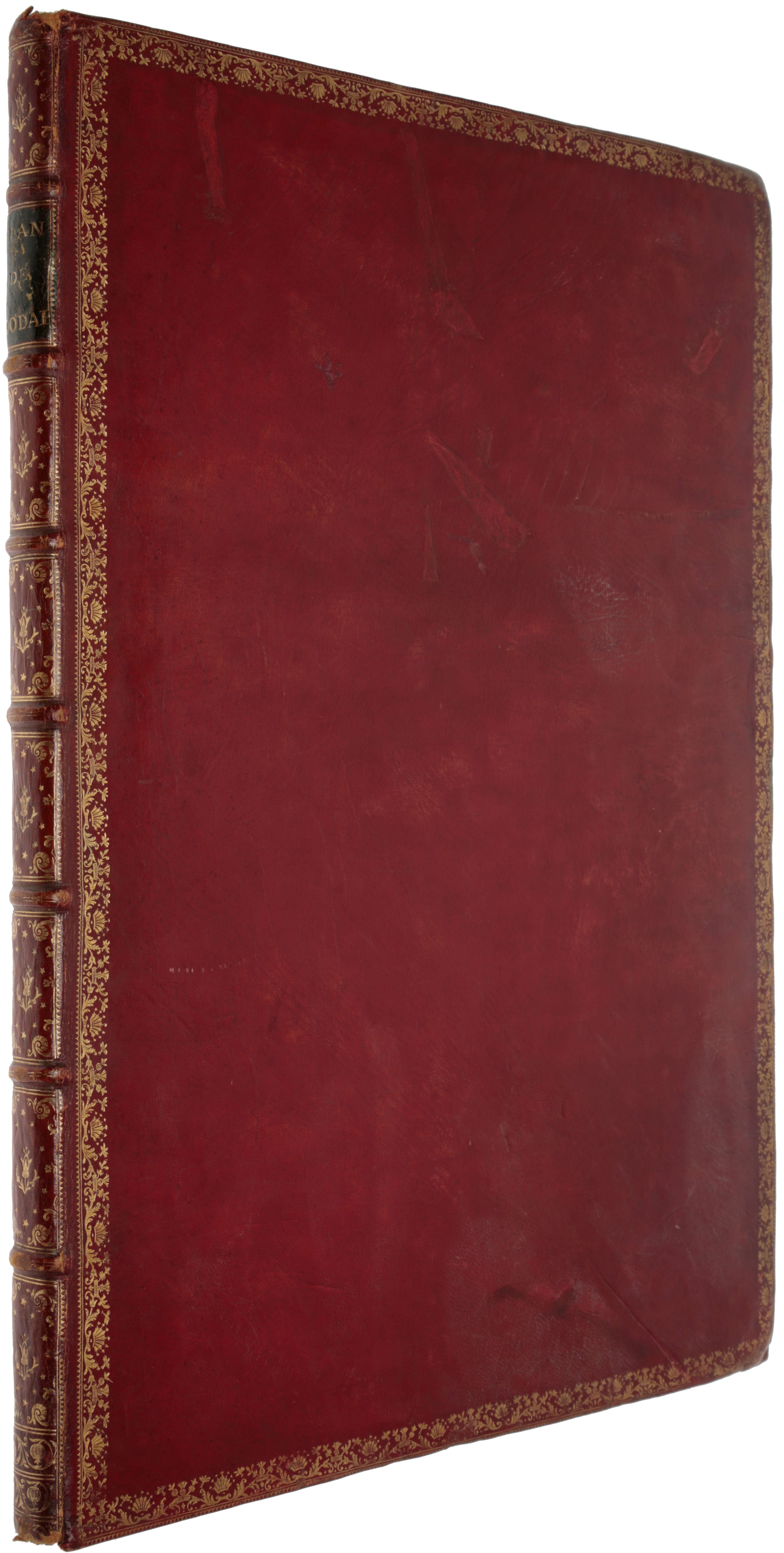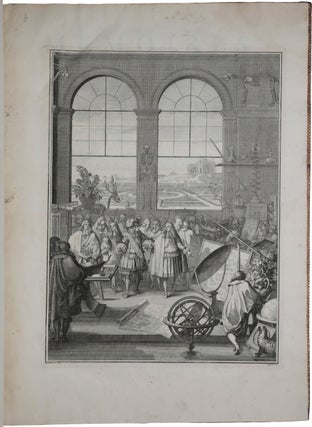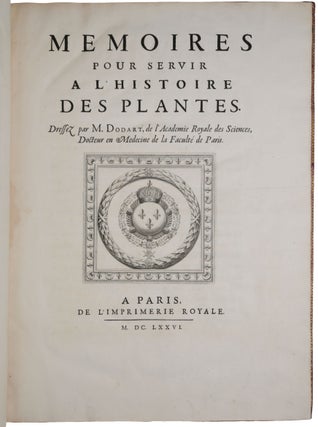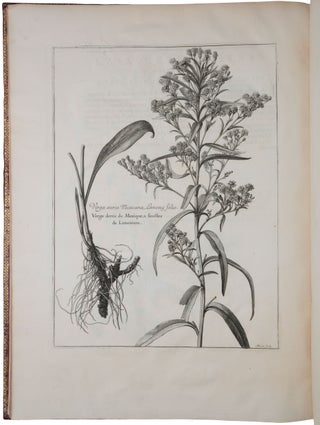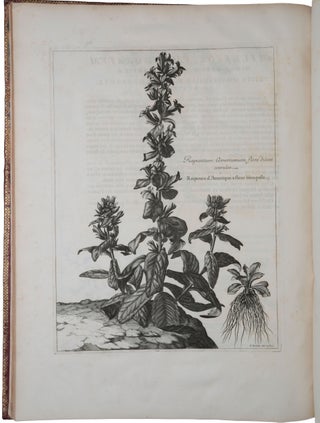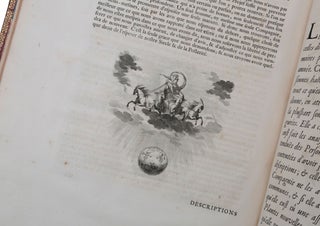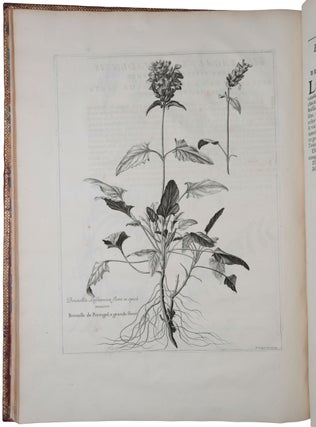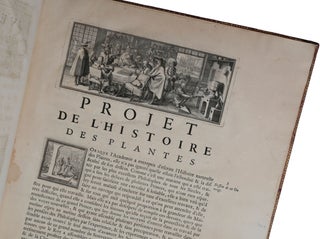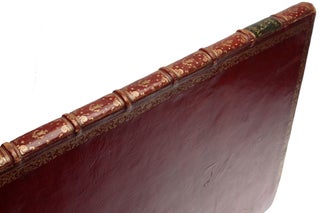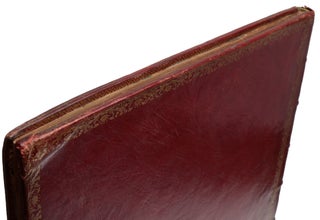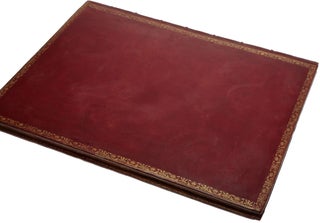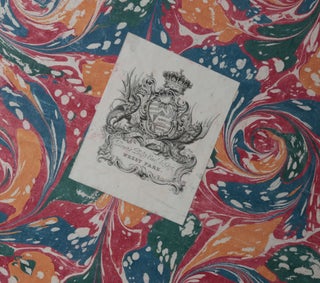Mémoires pour servir à l’Histoire des Plantes.
Paris: Sebastien Mabre-Cramoisy at l’Imprimerie Royale, 1675 [colophon date]-1676 [title page date]. First edition of “one of the great books in the history of botanical illustration, where all the technical resources of engraving were utilized in presenting the plants as accurately as possible” (Hunt), here accompanied by 5 additional engraved plates. “The idea had originated with Claude Perrault in 1667. When Dionys Dodart (1634-1707) was elected to the Académie in 1673, the proposal took definite shape, and at the end of 1675, the latter’s Mémoires pour servir à l'Histoire des Plantes was published by the Royal Press. This volume, a large folio, was planned as the prelude to a vast work whose publication was delayed for many years. Its 39 plates were engraved from drawings by Nicolas Robert (1614-85), made for the most part from life; in the case of several rare plants he was obliged to adapt paintings which he had previously made on vellum at the Jardin du Roi … he was assisted, or perhaps directed, by the engraver Abraham Bosse (1602-76) … In the preface to Dodart’s Mémoires the intention of the illustrations is clearly defined. Wherever possible, the plants were to be portrayed life-size; if larger, but not more than twice the size of the page, they would be represented as cut in two; if still larger, some detail would be given full-scale, so that the true size of the plant could be better appreciated. Moreover, all the technical resources of engraving were to be fully utilized. The preface continues: ‘Since printing in colour is not employed yet, and since painters waste much time and are not always successful, we thought we could, in future, supply to some extent what was lacking in an engraving, by taking care to indicate, as far as is feasible, the depth of the colour. Thus a distinction would be made between brownish-green and pale green, between white and dark-coloured flowers …’” (Blunt, pp. 111-2). These techniques led to images of such remarkable beauty and quality that numerous authorities agree that Dodart’s plates “rank among the best botanical engravings ever produced” (Bridson & Wendel). “The Mémoires contains a methodological introduction and a model showing how to conduct botanical research. Because of Dodart’s recommendation of phytochemical analysis, this work marks a new step in botany” (DSB). The first part (‘Projet de l’histoire des Plantes’, pp. [1]-52) establishes the need for the work and the form of the descriptions and illustrations of the plants, and the second part (‘Descriptions de quelques Plantes nouvelles’, pp. 53-131) comprises descriptions by N. Marchant and illustrations after Nicholas Robert of 39 species ‘dont la pluspart sont rares, & n’ont jamais esté ny décrites, ny figureés’ (p. 53), in accordance with the structure proposed in the first part, describing the plants, their attributes, and the sources of the specimens. The frontispiece depicts a meeting of the Académie in the Royal Library at Versailles, with Louis XIV and Colbert in attendance. This is the first published illustration of an assembly of a learned society. Of the five additional loose plates that accompany this copy, three appear in the work (those on Nn, Ooo [repeated on Ppp] and Qqq), but without the text on the verso. The two remaining plates of Tithymalus Americanus nodifloris and Aster Verbasci folio were apparently intended for the work and engraved by Louis de Châtillon. All are uncut. ABPC/RBH list 8 copies (of which 2 lacked the frontispiece). Provenance: Thomas Philip de Grey, 2nd Earl de Grey (1781-1859), known as The Lord Grantham from 1786 to 1833, Tory statesman and politician and first President of the Institute of British Architects in London (Wrest Park bookplate); acquired from Lucien Goldschmidt, 1964. Bookplate of Arthur & Charlotte Vershbow. Sold Christie’s New York, 20 June 2013, lot 487. Christian Huygens was the first to propose that the newly-formed Académie des Sciences publish a natural history. It was to be universal and Baconian, and must study weight, temperature, color, magnetic attraction, the composition of elements, animal respiration, the development of metals, plants and bones. This proposal was in fact one of the reasons which convinced Jean-Baptiste Colbert and his ministers to found the Academy of Sciences. However, it was modified and became two separate projects, dealing with animals and plants. Claude Perrault, a close friend of Huygens, proposed in January 1667 that the Academy publish a natural history of plants. Perrault was inspired especially by Bauhin’s Pinax (1623), which Nicolas Marchant had already begun to revise. Perrault identified two ways of organising this study: pure botany, which studies the history of plants through the study of the external characteristics and therapeutic properties of plants, an approach going back to Aristotle's Historia animalium; and natural philosophy which aims, following Theophrastus and Francis Bacon, to research the causes of the medical properties of plants, plant reproduction and plant nutrition. According to Perrault, this approach involves chemical analyses, observation of seeds and pollen under a microscope, experimentation and testing of certain contemporary theories on propagation and generation, including the study of whether the sap circulates in plants like blood in the human body. The Academy at first decided to concentrate on the species of Europe and the Near East, leaving the study of American flora to the Minime priest Charles Plumier. Perrault worried about the continued support of the crown, and decided that a more modest publication has a greater chance of success and should help persuade the government to fund more in-depth research which could lead to a more comprehensive work being published later. Perrault himself took on the project of producing a History of Animals, published the counterpart to the Mémoires des Plantes in 1671 and 1676, the Mémoires pour servir a l’Histoire naturelle des Animaux. Samuel Cottereau Duclos (1598-1685), Perrault’s protégé, was appointed director of the History of Plants project.To the initial elements, engraving and description of the plants, he added a classification, according to the system of Theophrastus, and chemical analyses to the work.He distilled the plants in order to reveal their chemical constitution so that he could include in their description the consistency, colour, smell and taste of their components.Duclos believed that the work should concentrate on French plants, but his colleagues dreamed of creating a work that describes the plants of the whole world and the work was not in the end restricted to the national flora. The work was to be written in the vernacular – the Sun King and his ministers were probably unfamiliar with Latin. Nevertheless, Duclos envisioned a broad audience of natural philosophers for the Mémoires des Plantes, not fully grasping that the Academy’s publication needed primarily to impress an audience of one – Louis XIV. Progress on the Mémoires des Plantes was slow, and in 1673 Denis Dodart took over the project. The pragmatic emphasis of the physician Dodart preempted the natural philosophical aims and theoretical concerns of the chymist Duclos, and redirected the project. Dodart reaffirmed that the aim of the Academy was to describe all existing plants, and accepted many of the criteria set out by Perrault and Duclos for these descriptions. Marchant also passed on to him his long experience on how to write descriptions. However, Dodart limited his descriptions to the parts of plants which allow their recognition, or which make it possible to discover the use of the plant, or which reveal ‘some particular industries of nature.’ Dodart also announced that the artists of the Academy would only refer to Duke of Orleans’ collection of watercolors on vellum if Marchant was unable to grow certain rare plants. At the beginning of the work, Dodart affirmed his Baconian principles: ‘We will verify by these experiences what the Ancients & Moderns have advanced on all this with these precautions; 1, not to dwell on manifestly superstitious observations; 2, to observe all that will not be such, and not to decide in this respect the possible or the impossible by any conjecture; 3, not to condemn as false what will not have succeeded for us, but to only recount the process and the success of our experiments ….’ (p. 8). Dodart also introduced the physiology of plants into the work. He explained how each plant develops, excluding the question of nutrition or the movement of the sap, but the cultivation of plants itself led to analyses of germination and soil. No academician had included these subjects in a natural history before. The work is made up of five chapters: I, Descriptions of the plants; II, Figures of the plants; III, The cultivation of plants; IV, The virtues of plants; V, The history of plants. The fourth, longest, and most important chapter, on the ‘virtues’ of plants, discusses their chemical composition. The 39 descriptions, written by Nicolas Marchant, vary greatly in length, from one page to a few lines. They are ordered alphabetically, facing the associated engraving. Some descriptions specify the origin of the specimen. Thus, there are two of Jean Richer (1630-1696), “from the Royal Academy of Sciences, sent by the King to Acadia & Cayenne for astronomical and physical observations”, two by Monsieur Griffelet (or Griselay) from Portugal, “professor of botany and chemistry”, one of Mr. Denison “who is very curious and very intelligent”, two of Mr. Magnol “doctor of medicine, very learned in the knowledge of plants”, one of Mr. Andrea da Roffo, “Gentilhomme Florentin”, and one by Gaston de France. It is specified that eight come from America (including Acadia, Brazil, Cayenne, Canada), two from the gardens of Blois and Chambord, five from the south of France, two from Portugal, four from Italy, and one from Syria. The engravers were inspired by the watercolors produced by Nicolas Robert for the collection of the Duke of Orleans in Blois, bought by the Royal Library and transferred to Paris. However, under Dodart’s direction, they studied specimens from life whenever possible. Perrault asked for the creation of an “Academic Garden” for this purpose, and in the 1670s Nicolas Marchant managed part of the vast grounds of the Royal Garden of Medicinal Plants on behalf of the Academy under the name of the Petit Jardin. They drew delicate parts or very small plants with the help of a microscope. The technique of etching was preferred to intaglio so as to suggest gradations of colour. The illustrations showed the actual or relative size of each plant and its appearance in its natural state. Sometimes a juvenile state is represented, Dodart using the term “the nascent plant” to distinguish them from “the perfect plant”. The work had 39 plates, but Trifolium echinalo capite and Trifolium blese are illustrated by the same plate, reproduced twice. The first is l'Angélique d'Acadie, first described by Dodart in 1666. Michel-Eugène Chevreul underlined in February 1858 the merits of chapter 4, which introduced the use of chemical analysis to analyze the properties of plants: “It is impossible,” he wrote, “to have better understood the spirit of the research that a knowledge of plants requires in general, and in particular from a chemical point of view, than Dodart did … No correct idea of organic analysis then existed, and Dodart, by accepting the expression ‘virtues of plants’, made a perfectly correct criticism of the way in which Antiquity and the Middle Ages had made use of it; consequently, he insisted on the need to ascertain first of all whether a certain virtue, which had been attributed to a plant, really existed, then he indicated how to proceed to discover new ones. And the word virtue was for him synonymous with the word property, because he extended it to the faculties that plants may have of being used for the preparation of lacquers, for dyeing, etc.” (Journal des Savants, February 1858, pp. 113 & 116). Bridson & Wendel, Printmaking in the Service of Botany 16; Brunet II, 785; De Belder sale 107; Graesse II, 415; Hunt 343; Nissen 502; Plesch sale 210; Pritzel 2341.
Broadsheet folio (548 x 406 mm), pp. [vi], 131. Engraved frontispiece by and after Sebastian le Clerc, printed by Goyton; 39 engraved full-page illustrations (28 by and after Nicolas Robert [1614-85], 11 by Abraham Bosse after Robert); engraved headpiece, tailpiece and initial; accompanied by 5 additional engraved plates (see above) (some occasional pale spotting, a few small stains). Contemporary French gold-tooled red morocco, spine in eight compartments with seven raised bands, black morocco lettering-piece in one, repeated floral design in the remaining, edges gilt (some wear at ends of spine, a few repairs on sides).
Item #5358
Price: $135,000.00

